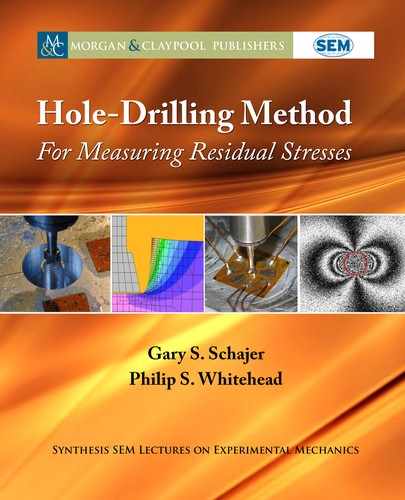10 1. NATURE AND SOURCE OF RESIDUAL STRESSES
strengthening effect is solely due to the presence of the residual stresses induced by the initial
overload. e effect is separate from any strain-hardening that may also occur. Figure 1.8 shows
that the strengthening effect occurs with a perfectly plastic material that does not strain harden
at all.
Figures 1.8a,b,c show how local plastic deformation can create material misfits and result-
ing residual stresses. is is the most common situation. However, it can also happen that global
plastic deformation can relieve misfits and residual stresses. If an axial tension were applied to
the unloaded beam in Figure 1.8c, all stresses would uniformly become more tensile. Figure 1.8d
shows the resultant stresses when the maximum stress just reaches the tensile yield stress. is
loading is purely elastic. Figure 1.8e shows the stress distribution that occurs when the axial
tension is increased such that additional plastic deformation occurs. As can be seen, the effect is
to reduce the variation in the stress profile across the beam width. With yet further axial tensile
load, as in Figure 1.8f, the plastic deformation spreads across the full height of the beam. All
material is at the yield stress, thereby reducing the stress variation into a uniform profile. is
response has effectively equalized the material misfits created by the initial bending. us, when
the beam in Figure 1.8f is unloaded, it will be residual stress-free.
e tensile stretching in Figures 1.8d,e,f, called “stress leveling,” does not reverse the mis-
fits created during the initial bending in Figures 1.8a,b,c it “equalizes” them. After load release
from the final tensile stretching in Figure 1.8f, the beam is longer than initially. A material that
work hardens will not give a perfect equalization of the misfit distribution, but will “wash out”
the previous residual stresses by reducing both their size and spatial variation. Figure 1.8e il-
lustrates the reduction in spatial variation. Manufacturing processes such as wire drawing and
extrusion involve substantial plastic deformation, but typically produce only modest residual
stresses because of this “wash-out” effect.
1.3.4 SURFACE MACHINING
During component manufacture, many material removal processes—such as turning, milling
and drilling—involve the application of highly localized mechanical and thermal loads. e
newly formed surfaces typically contain significant residual stresses. Stress magnitude and pen-
etration depth typically depend on the rate of material removal and the geometry/sharpness of
the cutting tool, the material hardness and the use of lubricants/coolants. For many machin-
ing processes, the direct effects of machining may penetrate to depths within the range 50 m
(“fine” machining) to 1 mm (“rough” machining). Near-surface tensile stresses in the direction
of machining are often greater than those in the transverse direction; details of tool geometry
can also influence the magnitudes of shear stresses and the resulting principal stress directions.
In many grinding processes, the temperatures reached at the cutting surface usually exceed
those for conventional machining, while mechanical loads may be somewhat smaller. Accord-
ingly, thermal loading may be the predominant producer of residual stresses at the newly-formed
surface. Because of the relatively low mechanical load input, near-surface residual stresses may be
..................Content has been hidden....................
You can't read the all page of ebook, please click here login for view all page.
